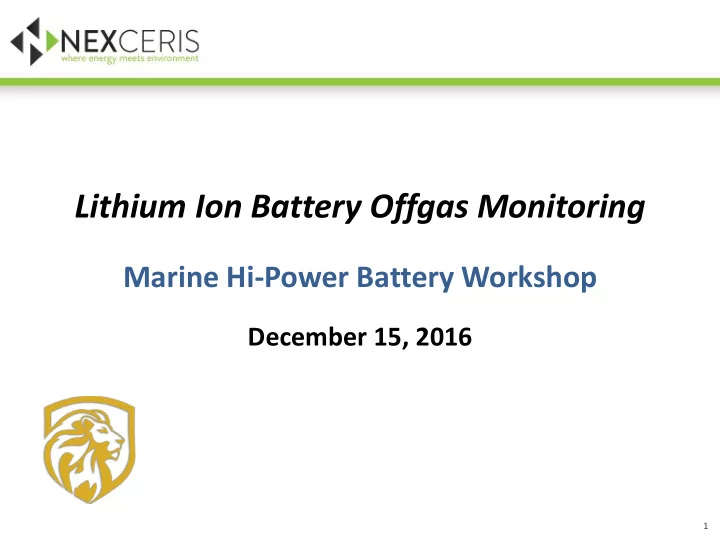

Lithium Ion Battery Offgas Monitoring Marine Hi-Power Battery Workshop December 15, 2016 1
Overview Nexceris Introduction Li-ion Battery Safety Problem Why Off-Gassing is important Capability Product Development Status Acknowledgements 2
About Nexceris Nexceris, LLC Founded in 1994, privately held Technology Developer o advanced ceramics, electrochemical devices Product Developer o fuel cells, catalysts, sensors and monitors Manufacturer/Distributor o fuel cells and related products, sensors ISO 9001:2008 certification o covers all products and operations Changed name from NexTech Materials to Nexceris on October 1, 2015 www.nexceris.com 3
About Nexceris Our Vision Nexceris focuses its materials science expertise on creating innovative products that improve the quality, efficiency, and safety of energy and environmental systems, while providing maximum value to our customers. 4
Our Brands NTM Sensors provides gas sensors and monitors for hydrogen gas safety fuelcell materials.com is our sales division to supplying high quality fuel cell and battery materials, coatings, and related materials for R&D and OEM markets. 5
Problem Statement Lithium Ion Battery Safety Lithium-ion batteries are concentrated energy sources that can cause catastrophic events when abused In rare cases, batteries can cause catastrophic events even when not subjected to improper conditions The desire for safer battery systems is not only the ability to isolate these events when they do occur, but also the ability predict and, ideally, avoid them altogether 6
Lithium Ion Battery Incidents High Profile Examples NHTSA initiated $8.75M study after lithium ion battery related car fires (2012) FAA grounds Boeing 787 after issues with lithium ion batteries (2013) Battery fire ended the Navy’s Advanced Seal Delivery System Program (2008) Samsung recalls millions of Galaxy Note 7 phones (2016) 7
Military Applications High energy density batteries are essential for modern military systems: Navy/Marines: Direct energy weapons, auxiliary power on ships, unmanned underwater vehicles, battery storage/transport Air Force: Auxiliary power on aircraft, unmanned aerial systems Army: Soldier power systems, target acquisition systems, UAVs and UGVs 8
Failure Modes Cell Failure Non-Energetic Energetic Failure Failure Capacity Cell Dry Initiation of Thermal Electrical Mechanical Loss Out Disabling Abuse Abuse Abuse Mechanism 9
Critical Safety Concerns Short Circuit: Rapid release of heat and gas Thermal Runaway with Active Materials: Material decomposition, gas evolution, electrolyte combustion Electrolyte Degradation, Gas Generation and Flammability: Overpressure and cell venting, flammable electrolyte ejection Propagation: Failure is not contained to one cell 10
Battery Safety Approaches Space Ventilation Fire Protection Air Temperature Regulation Sub-Pack Pack BMS Master BMS Voltage Sensing Controls Sub-Packs Temperature Redundant Sensing Module Sensing Multiple battery cells with series and/or parallel connections 11
Battery Safety Approaches Cell Level Burst Disk/CID Separator Materials Module Level Thermal Management Battery Management Systems (BMS) Robust Design of Enclosure Pack Level Master BMS Redundant Sensor Systems Space Level Fire Suppression Temperature Regulation Lithium-ion battery reliability and safety is generally considered a function of the entirety of the cell, pack, system design, and manufacture Nexceris approach uses early detection of off-gassing to prevent failure 12
Off-Gassing Characteristics MEC evolves before thermal runaway 13
Thermal Abuse Testing Test Chamber Nexceris Sensor Battery Heater Gas In (Purge) Gas Out (Purge/Sample) Sample Tubing (PTFE) Sample Pump Selector Valve To Exhaust Vent Gas Cylinder(s) Common Exhaust Exhaust Pump Chamber is designed to monitor battery off-gas during abuse testing. Pump allows for bag samples to be collected for third party analysis. 14
Thermal Abuse Testing Sensor responded prior to temperature spike by 10-20 minutes under thermal runaway test conditions. Confirmed gas species with bag sample analysis. 15
Battery Failure Testing Nexceris has built capabilities for characterizing failing batteries and designing systems around prevention of catastrophic events Enables understanding of off-gassing characteristics of all lithium ion battery cell form factors and chemistries Nexceris has tested cylindrical, pouch, and prismatic cells and continues to characterize off-gassing mechanisms for battery safety stakeholders 16
Battery Failure Testing A lithium ion pouch cell was abused An enclosure was created to contain with overcharge to induce failure the test and simulate a battery module Testing performed with support from Battery Innovation Center 17
Early Detection of Thermal Runaway Pouch cell Nexceris overcharged Li-ion Tamer™ at 3C rate AWARE Detected off-gas 90 seconds prior to thermal runaway Mitigating action taken on subsequent tests prevented thermal runaway 18
Early Detection of Thermal Runaway Overcharge failure test (5C charge rate) Off-gas detected 2.95 minutes in advance of thermal runaway 19
Mitigation of Thermal Runaway Overcharge failure test (5C charge rate) Charging suspended when off-gas detected Thermal runaway avoided 20
Li-Ion Tamer Aware™ Product release in Q2 2017 Integrated with BMS – plug and play design Early warning signal for shut-down or other mitigation One monitor per battery module Added layer of safety 21
Possible Use Scenarios Communication Directly with Communication Slave BMS Bypasses BMS Additional Layer Information Fed of Safety Integrated Directly to Independent with BMS Master BMS Redundancy of BMS in Shut Down Class D Extinguisher Bypassable Modules Creates Redundant Sensing System 22
Product Development Status We are looking to design our product into next generation military, packaging, laboratory, and maritime systems Testing with batteries to evaluate our product over a range of possible use scenarios Assessing off-gassing characteristics, possible mitigating actions, and early indication trends Providing beta-prototypes to customers System integration and customer testing 23
Li-ion Tamer Product Team Steve Cummings Nick Frank Acknowledgements Bill Dawson Scott Swartz 24
Recommend
More recommend